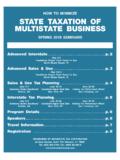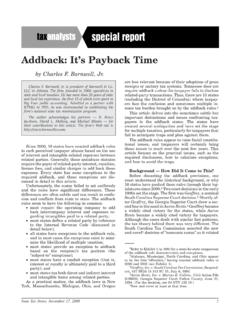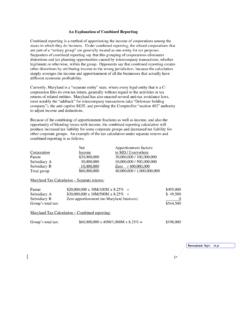Transcription of The Sales Factor: Top Five Issues Taxpayers Need to Consider
1 Journal of multistate taxation and Incentives (February 2008) Department: CORPORATE FRANCHISE AND INCOME TAXES The Sales Factor: Top five Issues Taxpayers Need to Consider The Sales factor is becoming dominate in multistate apportionment; this leads to opportunities for the nimble and traps for the unwary. Author: CHARLES F. BARNWELL, JR. CHARLES F. BARNWELL, JR., CPA, is President of Barnwell & Company LLC, in Atlanta, Georgia. The firm, founded in 2000, specializes in state and local taxation . Mr. Barnwell has more than 20 years of state and local tax experience, the first 15 of which were spent in Big Four public accounting. Admitted as a partner with KPMG LLP in 1991, he was instrumental in establishing and leading the firm's national State Tax Minimization(SM) program for five years.
2 Mr. Barnwell received the Elijah Watts Sells Award for outstanding achievement on the CPA exam, and he has spoken extensively on state and local taxation before state CPA societies, the Tax Executives Institute, COST, the Federation of Tax Administrators, the Institute for Professionals in taxation and other professional associations. This article is based on the author's presentation at the "2007 Income Tax Symposium" presented by the Institute for Professionals in taxation in Sarasota, Florida in November 2007. The author acknowledges the following individuals for their contributions to this article: Scott M. Dayan, Esq., Kilpatrick Stockton LLP, Atlanta, Georgia; and his Barnwell & Company colleagues, R.
3 Bruce Jacobsohn, CPA, David L. Mallory, Esq., CPA, and Marc L. Schwartz, Esq., CPA. This article appears in and is reproduced with the permission of the Journal of multistate taxation and Incentives, Vol. 17, No. 10, February 2008. Published by Warren, Gorham & Lamont, an imprint of TTA. Copyright (c) 2008 Thomson/TTA. All rights reserved. The effect that the Sales factor has on state income tax liabilities of multistate Taxpayers has grown significantly over the past several years. Currently, ten states impose a "single Sales factor" method, 1 and more than 20 others give greater weight to the Sales factor. 2 The current emphasis on the Sales factor contrasts with the apportionment landscape in earlier years when the Sales factor was typically equally weighted with the payroll and property factors .
4 3 Today, fewer than a dozen jurisdictions still generally employ the "standard" three-factor formula. 4 If this trend continues, one may reasonably assume that those "standard" states will emphasize their Sales factors as well. The extra weighting of the Sales factor has some interesting implications. Does a single, Sales -factor apportionment regime, with no consideration given to a taxpayer 's payroll or property, fairly reflect the taxpayer 's activity within a state? 5 The inclusion of payroll and property dimensions of a taxpayer 's activity would seem to lend a balance to the measurement of the taxpayer 's overall in-state business. If the extra-weighting of Sales does not fairly reflect a taxpayer 's in-state activity, is such unfairness sufficient to violate constitutional standards?
5 The reliance on a single or heavily weighted Sales factor would seem to afford a taxpayer a degree of planning flexibility since the taxpayer need alter only one aspect of its business to significantly alter the apportionment percentage. Moreover, as compared to the payroll and property factors , the Sales factor is arguably less precise in terms of its "geography" ( , jurisdictional sourcing) and, therefore, more easily rearranged to accomplish various planning agendas, as discussed further below. Ironically, the Sales factor was initially excluded from the recommended standard apportionment formula by a federal congressional panel (the "Willis Committee"), which believed that payroll and property were better measures of in-state activity.
6 6 The Sales factor was included in the original Uniform Division of Income for Tax Purposes Act (UDITPA), however, and became an equally weighted part of the standard three-factor method of income attribution. If a heavily weighted Sales factor facilitates the tax planner's agenda, why have the states moved toward an emphasis on the Sales factor? Is the trend based on states' needs for revenue? Is the adoption of the Sales factor a competitive economic weapon to attract industry? The Sales factor can be said to "export" the tax base to out-of-state Taxpayers , and to create an incentive for in-state business. The states' quest for a fair playing field seems to have been tossed aside in the fight for in-state economic investment.
7 Because apportionment is intended to divide a taxpayer 's total taxable business income among the states in which that taxpayer operates, logic would seem to demand that the Sales factor include those receipts that generate business income. Similarly, receipts that generate nonbusiness income, which is allocated rather than apportioned, logically should be excluded from the Sales factor. With respect to nonbusiness income, logic prevails. 7 Receipts giving rise to nonbusiness income are excluded from the Sales factors of all states. But logic seems to break down with respect to business income, because even if certain Sales give rise to apportionable income, those Sales are not necessarily included in "total" Sales , , the Sales factor denominator.
8 The authors of UDITPA added a comment in 15 stating: "The Sales to be included in the [ Sales factor] fraction are only the Sales which produce business income." 8 In many cases, the states have interpreted this language to mean that while all nonbusiness income must be excluded from the Sales factor, all business income is not necessarily included in the Sales factor. UDITPA 18 provides for alternative methods when the standard formula does not fairly represent the extent of a taxpayer 's business activity in a state, 9 and many states have interpreted this section to allow the exclusion of receipts resulting from the incidental occasional sale of business assets, which receipts normally are considered business income.
9 10 The statutory intent appears to be to exclude extraordinary items that might skew the apportionment factor within a particular accounting period. The concept seems to be based on the assumption that the vast majority of a typical taxpayer 's taxable income in every tax year is from normal business operations. In the year in which a taxpayer sells a substantial portion of its business assets, however, the vast majority of the taxpayer 's income may be from the occasional sale of those assets. Thus, the UDITPA 18 exception can and often does lead to less fairness, in direct contrast to its intended purpose. Another important exception to "total Sales " is the exclusion from the Sales factor of income from intangible property that is not associated with any particular "income producing activity" of the taxpayer ( , interest, dividends, royalties, capital gains, and similar receipts from the "mere holding" of intangibles).
10 11 The result of this rule: the inclusion of income in the tax base subject to apportionment with no factor representation. This exception can and often does lead to unfair or distorted results and Taxpayers should be vigilant in identifying such circumstances. If the taxpayer identifies a clearly distorted or unfair result prior to the filing of the return, the taxpayer has a better chance to petition the applicable state tax authorities for alternative apportionment. The general treatment of dividends for state tax purposes often results in a different kind of mismatch. Dividends from subsidiaries are certainly receipts, and therefore normally the taxpayer would include such dividends in the Sales factor.



